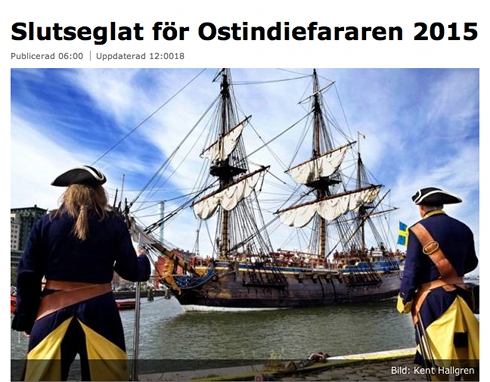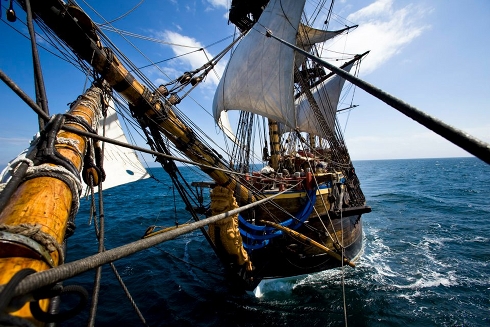Photo: Kent Hallgren.
The Swedish East Indiaman Gotheborg III in GP 11 April 2013.
Text © JE Nilsson, CM Cordeiro 2013
Though I’ve been in Sweden for just about a decade, I wonder if it is only I who have grown tired at the consistent gloomy headlines of the local Swedish newspapers when writing about the Swedish East Indiaman Gotheborg III, the latest headlines reading – No more sailing for the East Indiaman.
I wonder if this sensationalization of headlines is but a low end marketing attempt to attract readership since there is a general consensus of the ship itself being an entity of high interest. But what these pessimistic headlines reflect however, is a probable trend of lack of confidence in what is considered a good investment for the city of Gothenburg, and a business opportunity that can generate great dividends to all.
The Swedish East Indiaman Gotheborg III cannot help but be a symbol of the international harbour city of Gothenburg, with its rich history of daring merchants traveling the world, establishing global companies and one that have since long twinned its future with cities like Shanghai in China.
That the ship could do with more money is nothing new. What we need to bear in mind though, is that money does not create ideas. It is ideas that create money.
That the ship should be made into a museum even after 2020 without consideration of its larger context would be shortsighted planning and a terrible waste of resources. An East Indiaman ship museum would immediately be compared to the Vasa museum in Stockholm by visitors who know little of the East Indiaman history, compared to the Vasa which has become a monument over time, and a prime example of publicly funded projects.
Ironically, the Vasa was too large, too unstable, catering to prestige rather than function, built to government specification, managed by bureaucrats and naturally sank just minutes after being launched, already in 1628.
The East Indiaman Gotheborg III was founded on a different heritage and set of values that in turn rendered a fully functioning sailing vessel that looks her most glorious when sailing in the open seas.
Photo: Jakob Rempe.
The Swedish East Indiaman Gotheborg III in its Europe Tour 2013, Leg 1 at sea.
The first East Indiaman Gotheborg came within viewing distance of its home harbour before she hit a rock and sank in 1745. The Gotheborg II foundered outside of Cape Town in South Africa in 1796, and the Gotheborg III made it all the way back home in 2007. This is the true entrepreneurial spirit of the ship, one that does not take a complete failure as a no, but just go for it again since it is the right thing to do, no matter!
Based on such authenticity and integrity, what benefits would anyone reap by turning the Gotheborg III into a museum that would still only be a country side mock-up version of the Vasa?
Tracing the journals that people keep about her, the documentaries and personal experiences of the crew onboard, the Gotheborg III is happiest when she has her people around her, who revel in learning from handling her ropes, her masts and her spirit of freedom.
Waters have more often than not united than divided, and the means for that are the ships – virtual or real. With this general enthusiasm and love for her comes the immense international goodwill for Gothenburg and Sweden set against the background of an increasingly polarized and fragmented EU.
China for example, doesn’t know much about Sweden as a country, but they know about the unique gesture of friendship that the entire project around the creation and sailing of the Gotheborg III was and still is.
While Stockholm might be the administrative heart of Sweden, the city of Gothenburg have always been the port city, with the complementary role of looking out into the world, with its international portfolio of shipping and trade.
As a testament to the entrepreneurial spirit of the city of Gothenburg, in 2011, Anneli Hulthén the Mayor of Gothenburg, received the award Entrepreneur for the World in the politicians’ category at the World Entrepreneurship Forum in Singapore.
The building of the Swedish East Indiaman Gotheborg III began as an entrepreneurial effort with a clear purpose of trade and cultural exchange. There is no reason why it should not be kept true to its entrepreneurial roots. That is were she began and that is where she belongs. Even as business climates change over the years, Gothenburg is still where such business giants such as SKF and Volvo AB were born.
That the City of Gothenburg would stop sponsoring the Gotheborg III is not the same thing as that the ship would need to stop sailing. On the contrary. Gothenburg and West Sweden must see itself in an international context where bringing in business and work opportunities is a prime concern, and to not see the potential in using the Swedish East Indiaman Gotheborg III to its very purpose to which she was built, one could argue, is not very clever.
As a first step towards an integrated perspective of the future of the Gotheborg III, the true history of the ship – as being a private venture started by entrepreneurs, needs to be understood – in order for it to fully leverage its goodwill capacities.
The ship also needs to be run in such a way that other entrepreneurs are encouraged to flock around her so as to also leverage the platform of opportunities that she offers.
What is needed is not lamenting the constant lack of money, but rather the realization that there are no ‘costs’. A sponsorship or a business agreement is just an investment that when properly put to work pays huge dividends to Gothenburg, to western Sweden, to Sweden as a whole, and to an ever fragmenting Europe that needs everything it has to keep itself together.
If something, it is time that the East Indiaman Gotheborg III should be placed in the hands of those who can see and do anything with the larger context. One that goes beyond Gothenburg and of Sweden and is in line with for example the European Commission’s Europe 2020 Flagship Initiatives for ’Smart Growth, Sustainable Growth and Inclusive Growth’.
Seen in that perspective, the Gotheborg III though a small piece in the overall picture of things, is much needed. And she is needed, alive and sailing!
As such, the open sea is where the Gotheborg III belongs, where she is more valuable as a sailing vessel than as a museum, beyond 2020.

